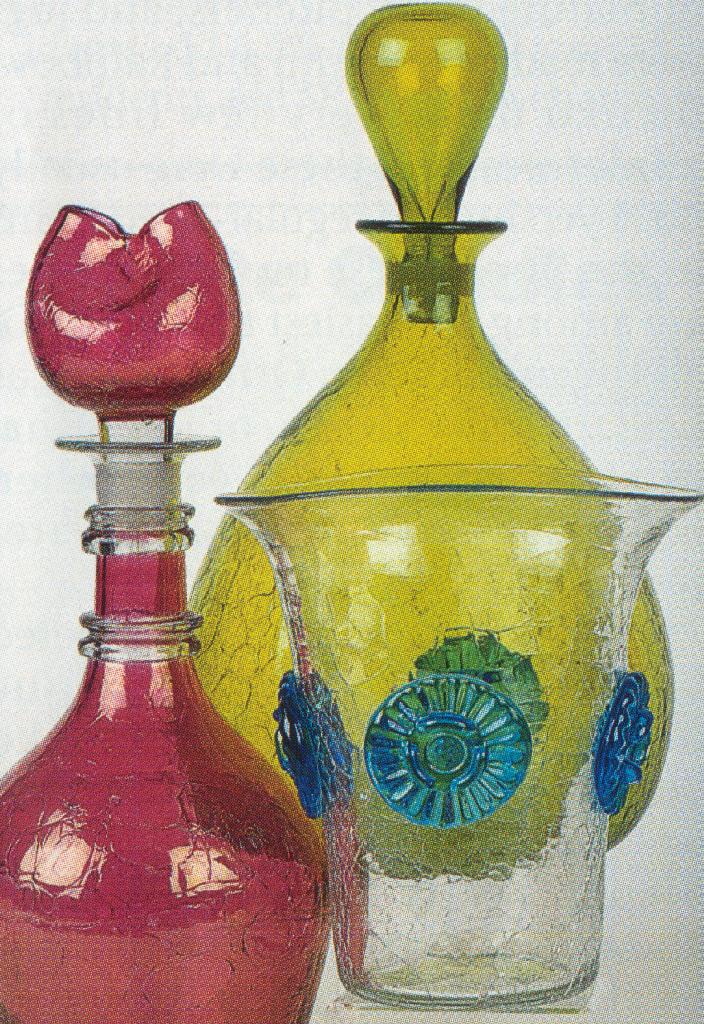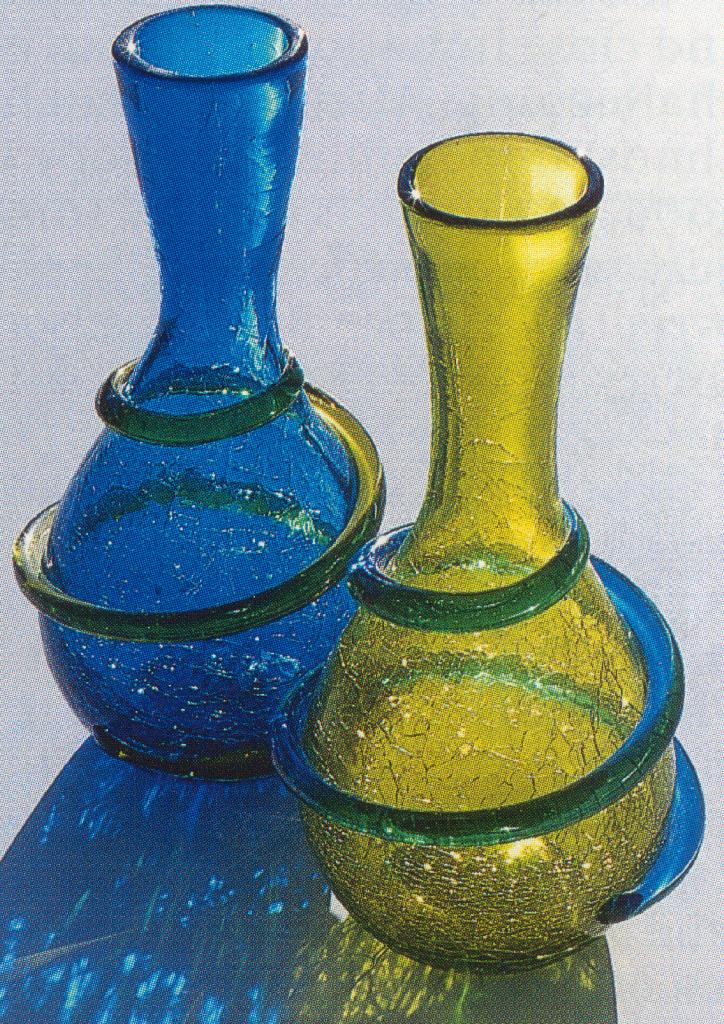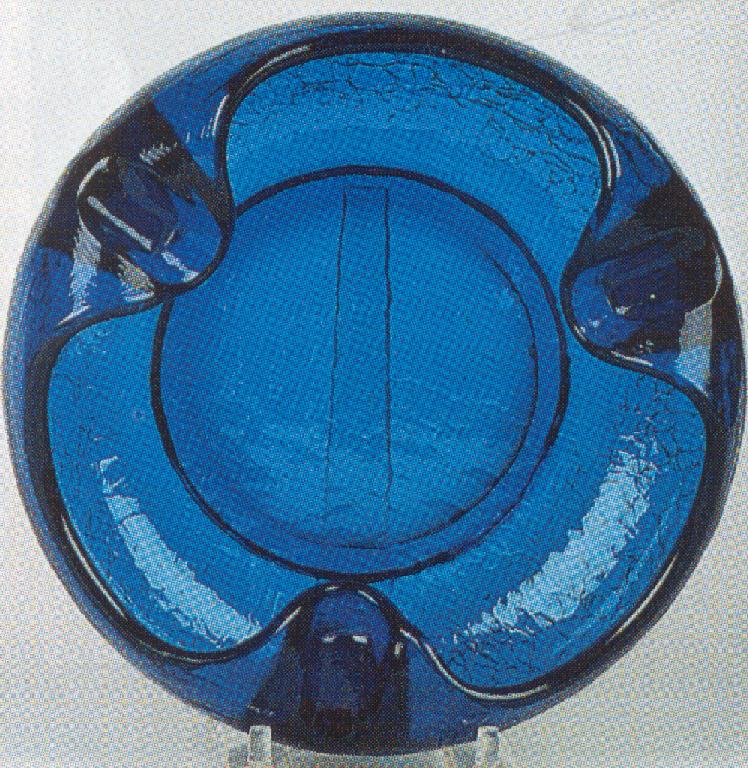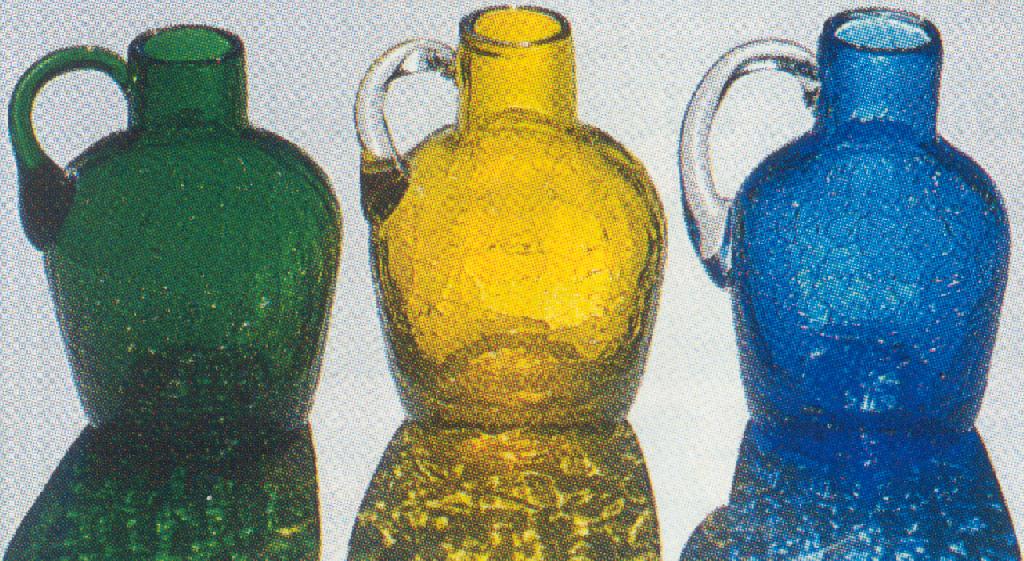
Crackle Glass: Focus on West Virginia
Written by Leslie Pina
Crackle glass is not a style; it is not by any particular designer or company; it is not from any one period of time. Crackle is a finish added to the glass to give it a cracked or crackled overall texture. This finish affects neither the color not the form of the piece. In fact, many designs, such as Blenko, could be ordered in either plain or crackle finish. The latter is added while the piece is hot, by immersing it in cold water. Sudden and extreme change in temperature shocks the glass and causes it to crack. It is then reheated to smooth and strengthen, leaving irregular line of crackling.
Because collectors of crackle glass focus on this special finish, collectors are widely varied -- from miniatures or "window" pieces in traditional forms, to big modern designer pieces. Generally, the small common examples command very reasonable prices, even though they are usually mouth-blown and hand-made. On the high end of the range are the Blenko pieces from the ‘50s and ‘60s sought after by other collectors. Mid-century modern enthusiasts often accessorize with these large brilliantly-colored pieces. And as might be expected, many of these designer pieces were copied (both carefully and badly) by several of the contemporary glass factories.

Unusual Rainbow decanter with cranberry stain and stopper
in the form of a pinched ivy vase; Blenko Olive Green bulbous
decanter by Wayne Husted; and early Blenko Crystal
vase with applied Blenko Blue rosettes.
It is this category of direct copies and close imitations that can be challenging. Attribution can be almost impossible if the copy is good, but there is usually some qualitative difference in addition to overall appearance. By comparison, the original design will usually stand apart.
Dozens of companies made crackle glass at one time or another, but during the years from about the late 1930s to the 190s, five West Virginia companies produced the majority of all crackle glass on the market today. Blenko, Pilgrim, Rainbow, Bischoff, and Kanawha (and to a lesser extent, Viking) were responsible for most of the colorful crackle glass seen at flea markets, shows, shops, malls, and on the internet. Other companies like Hamon, Empire, Heritage, and Bonita, made crackle glass, but without labels or published catalogs, these can be difficult to identify.
In addition to these factories, some of the large so-called Depression Era companies made a limited amount of crackle glass. Fry made some very early items; Tiffin made some unusual two-color items; Duncan made some crackle for Raymor around 1950; and even Imperial made some crackle tumblers. These Ohio and Pennsylvania companies only made crackle as a novelty or an extension of their regular lines of hand-made but not mouth-blown Depression Era glass. The state known for off-hand (mouth-blown) glass, including crackle, is definitely West Virginia.

Blenko Blue vase with Olive Green applied spiral, with vase
in reverse color combination, one of Joel Myers' '60s designs.
Generally, the majority of the miniature vases, pitchers, and jugs were made by Pilgrim and Rainbow. Blenko made very few lines of miniatures, and these were usually little versions of regular-sized items in the line. These modern shapes are among the easiest to identify of all the miniatures. Others, such as by Rainbow, Pilgrim, or Kanawha, can be confused with each other. Bischoff copies muddy the water further.
Most extremely large stoppered bottles, pitchers, and unique designs were created by Blenko designer Wayne Husted from 1952 to 1962. Distinguished from both Blenko’s early tableware designs and the modern forms introduced by their first in-house designer, Winslow Anderson, these Husted pieces have given Blenko its reputation as the leading producer of big colorful fifties glass. He was succeeded in 1963 by Joel Myers, who followed Husted’s lead and introduced other memorable modern designs.

Viking ashtray in vivid turquoise
Few of these outstanding designs were attempted by other companies, with the exception of Pilgrim designs by the Moretti brothers, Alessandro and Roberto. But Moretti designs introduced Murano style to Pilgrim rather than items suitable for crackle. Blenko models that were widely copied include the pinched ivy vases, a variety of pitchers, early stoppered bottles, and Anderson’s bent-neck decanter.
The other companies also introduced lines made to compete with, rather than copy, Blenko. Pilgrim had lines with satin finish, peach-blow decoration, speckles, Murano-styled animal figurines, and heavy cased pieces. Kanawha, usually distinguishable by its traditional forms and a molded foot rather than a pontil mark, also made cased items with white interiors and bright exteriors. Besides their blatant knock-offs, Bischoff produced some of the most bizarre forms of all. But all of these West Virginia companies were responsible for the crackle glass made during the mid-century decades. Those still in business, notably Blenko and Pilgrim, still produced crackle glass. It can be easily distinguished from other new crackle glass -- from the cheap molded items made in China and other countries, to one-of-a-kind studio pieces.

Pilgrim window jugs showing handle variations; the colored handles
were generally used in the 1950s, and the crystal handles in the 1960s.
To see more Crackle Glass photos CLICK HERE.
Blenko’s new crackle glass is often similar to their earlier pieces. Crystal with applied colored spirals and larger single-color pieces are still being made. In some cases they are already confused with the very collectible ‘50s crackle, and when the cellophane labels eventually fall off, they will probably merge into the larger category of vintage crackle that collectors are scooping up today.